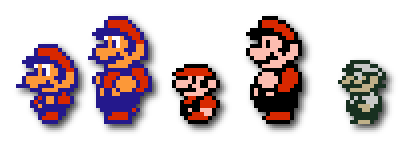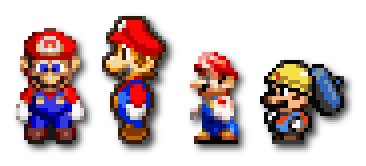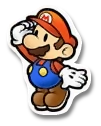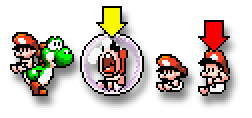
It all started...
 (note: parts of this article appeared in Nintendo Official Magazine UK, Sept. '04 issue)
(note: parts of this article appeared in Nintendo Official Magazine UK, Sept. '04 issue) Back in the day Nintendo was constrained by hardware. It's a well known story that when creating Mario - originally called simply 'jumpman' - Shigeru Miyamoto made him look the way he does because of hardware limitations of the time. He was given a mustache to seperate his nose from his face, overalls so arm movements were visible, and a hat because hair was hard to draw.
 Super Mario Bros 2
Super Mario Bros 2 first introduced us to a radically different looking plumber. Softer, rounder, with more personality owing in part to the graphics power of the NES and the growing experience of Nintendo's artists.
Sadly Nintendo pushed too far. In much the same way that early 3D games running on underpowered hardware produced hideous looking graphics (see: 3DO, Jaguar, SegaCD) Nintendo's use of pre-rendered sprites is running the risk of killing what charm Mario held as a lovingly hand-drawn sprite.
In order to maximize

the value of new artwork created for new games, characters like Mario are first drawn in 3D. This is the only time consuming part. Afterward the 3D model can be manipulated and posed in infinite variety and 2D sprites created in rapid-fire, assembly line fashion. In addition the same 3D model can be used in a sequel, and in 3D games with few or no changes. While it's faster than drawing each frame of animation by hand, the results are usually disappointing, and often very ugly.
Instead of pure colours and clearly defined edges, Mario now has a blotchy appearance - a result of reducing the number of colours in the 3D model. Instead of clear edges Mario's now saddled with aliased fringes, usually black, resulting in the kind of blue-screen border seen in old movies.

There are no signs Nintendo plans to change their ways. The fourth Mario on the right is unclear compared to every other, including the first one made more than twenty years ago. It's a shame that Nintendo, home to some of the world's finest 2D animators, is taking the quick way out and producing these ugly graphics. Many people consider 2D animation to be superior in many respects to the 3D graphics prevalent in modern games. If Nintendo keeps squandering their position as standard-bearer for this declining art form it will lead only to less joyous times for us all.
Mario History
Below is every 2D Mario ever released, from 1981 to 2004. They're divided into five distinct groups, showing the four different Nintendo styles and - as a bonus - how Mario looked on the consoles of the day, like the Atari 2600 and Colecovision.
Mario 1.0, 1981-1989
There were several similar iterations of the original Mario design, and he didn't change much between his first appearance in
Donkey Kong and subsequent games, like
Super Mario Bros and
Wrecking Crew. The changes that were applied were incremental. The eyes are usually made of a single pixel, and you can see how the resolution increase of the NES gave us two and three pixel eyes in 1985. In the arcades Mario was showing the whites of his eyes by 1983, a mere two years after his first appearance. It's interesting to note that the GameBoy Marios are always a generation behind, based on the year of release.

From Left:
Donkey Kong (1981, Arcade)
Donkey Kong Jr (1982, Arcade)
Mario Bros (1983, Arcade)
Wrecking Crew (1985, NES)
Super Mario Bros (1985, NES)
Super Mario Land (1989, GameBoy)
2nd Gen Mario, 1988-1994
Mario's appearance was locked in by Nintendo when
Super Mario Bros 2 was released. Rounder, friendlier, this is the plumber we knew and loved throughout Nintendo's reign. If you'll look at the Mario from 1994's GameBoy
Donkey Kong you'll notice it's nearly identical to the 1981 Arcade version, but for a shorter nose and a black outline.

From Left:
Super Mario Bros 2 (1988, NES)
Super Mario Bros 3 (1990, NES)
Donkey Kong (1994, GameBoy)
The Mario Renaissance, 1991-1993
The new
Super Mario World featured nearly identical designs to those seen in
Super Mario Bros 2 and
3, but the power inside the Super NES really gave Nintendo's artists the wings they needed to fly. In
Super Mario World there was, I think, a bit of haste that resulted in a colourful, but not necessarily
attractive Mario. A few years later all the Super Mario Bros games saw a retro fit with new, gloriously coloured sprites. This was Nintendo's finest Mario hour. The SNES versions of
Super Mario Bros 1, 2 and
3 are considered the definitive Marios.

From Left:
Super Mario World (1991, SNES)
Super Mario Bros 1 + 3 Allstars (1993, SNES)
Super Mario Bros 2 AllStars (1993, SNES)
Super Mario Land 2 (1992, GameBoy)
Jumping the Shark, 1996-2004
This is where Nintendo started to wobble. The 1996 release of
Super Mario RPG (admittedly produced by Square, not Nintendo) saw the first appearance of a pre-rendered, aliased Mario. Notice the dark colours around the edges, and the complicated overall appearance. The GameBoy Advance release of
Mario vs Donkey Kong, a reprise of the excellent 1994
Donkey Kong for GameBoy, is the worst offender. The smooth animation is impressive, however with it comes the harshest penalty. This Mario is indistinct and over-complicated. Aliasing isn't an issue, no doubt the result of countless hours of hand editing. The Mario from
Mario + Luigi is not pre-rendered, but is a significant change from the normal Mario style. Finally,
Wrecking Crew '98 Mario isn't pre-rendered, but seems to saddle the cute hammer-wielding Mario with some blotchy colours. Is that six o'clock shadow?

From Left:
Super Mario RPG (1996, SNES)
Mario + Luigi (2003, GBA)
Mario vs Donkey Kong (2004, GBA)
Wrecking Crew '98 (1998, SNES)
Mario's Shame, Early Home Ports
To no one's great surprise the consoles of the day were woefully unable to represent Mario in the proper glory. The Intellivision abomination is the worst offender, followed by Atari's distorted versions. Surprisingly the Colecovision nailed it perfectly, and the Commodore 64 version wasn't far behind.

From Left:
Atari 800 (Donkey Kong + Mario Bros)
Colecovision
Intellivision
Commodore 64
Atari 2600
Omissions and Errata
Quite a few people have pointed out some games they thought I missed, and I thought I'd detail them here.
Paper Mario is the first game that deserves mention, as it's really the next step in Nintendo's Mario design, replacing the pixelized sprites with what is, for all intents and purposes, an animation cel wrapped around a polygon. It's not a Mario sprite so much as it's a hand-drawn Mario image manipulated by the game.
 Yoshi's Island
Yoshi's Island, in which the player controlled Yoshi, and a baby Mario was the protectee. This doesn't really count as it certainly can't be compared to those above. However, here it is for completeness: 1995's
Yoshi's Island. One of the very best video games ever made.
 Mario & Wario
Mario & Wario, a Super NES game released for use with the mouse controller. You don't actually control Mario, it's more of a
Lemmings-style excercise where Mario walks and you try to keep him out of trouble by interacting with the environment. In addition, he spends most of the game with a bucket on his head.
 Mario's Time Machine
Mario's Time Machine,
Mario is Missing and other games in the Mario educational series released for the SNES. These games weren't produced by Nintendo, and the Mario sprites used were identical to other games, so they're not useful for this discussion.
There are a few other games I didn't include, like an unreleased Mario game for Philips' CD-I system, and games in which Mario played a cameo or background role, such as Dr. Mario, or Mario Golf. There are also some obscure computer ports of
Mario Bros and
Super Mario Bros which saw very limited release and kind of fall outside the scope of this article. Sadly I failed to consider the Virtual Boy Marios, from Mario tennis and Mario Clash. While the VB was a 3D system the sprites were mostly 2D. I'll look into this and, if they're not actually 3D, I'll include them down here near the bottom where they won't mess up my narrative. =)
Finally, as pointed out in
a forum post, the comparison of 1991's
Super Mario World and 1993's
Mario Land 2 was completely wrong, so I've removed it. The Mario's Shame section is accurate, none of those are out of order. And to back up my assertion that the
Donkey Kong Mario of 1981 and 1994 are nearly identical, here's a comparison of the two, along with a super-imposed version highlighting the different pixels. Not counting the new black outline and the feet, the only changes are white eyes, a rounder hat, and maybe ten other changed pixels. I stand by my statements. =)

Lawrence.
 (note: parts of this article appeared in Nintendo Official Magazine UK, Sept. '04 issue)
(note: parts of this article appeared in Nintendo Official Magazine UK, Sept. '04 issue) Super Mario Bros 2 first introduced us to a radically different looking plumber. Softer, rounder, with more personality owing in part to the graphics power of the NES and the growing experience of Nintendo's artists.
Super Mario Bros 2 first introduced us to a radically different looking plumber. Softer, rounder, with more personality owing in part to the graphics power of the NES and the growing experience of Nintendo's artists.
 the value of new artwork created for new games, characters like Mario are first drawn in 3D. This is the only time consuming part. Afterward the 3D model can be manipulated and posed in infinite variety and 2D sprites created in rapid-fire, assembly line fashion. In addition the same 3D model can be used in a sequel, and in 3D games with few or no changes. While it's faster than drawing each frame of animation by hand, the results are usually disappointing, and often very ugly.
the value of new artwork created for new games, characters like Mario are first drawn in 3D. This is the only time consuming part. Afterward the 3D model can be manipulated and posed in infinite variety and 2D sprites created in rapid-fire, assembly line fashion. In addition the same 3D model can be used in a sequel, and in 3D games with few or no changes. While it's faster than drawing each frame of animation by hand, the results are usually disappointing, and often very ugly.
 There are no signs Nintendo plans to change their ways. The fourth Mario on the right is unclear compared to every other, including the first one made more than twenty years ago. It's a shame that Nintendo, home to some of the world's finest 2D animators, is taking the quick way out and producing these ugly graphics. Many people consider 2D animation to be superior in many respects to the 3D graphics prevalent in modern games. If Nintendo keeps squandering their position as standard-bearer for this declining art form it will lead only to less joyous times for us all.
There are no signs Nintendo plans to change their ways. The fourth Mario on the right is unclear compared to every other, including the first one made more than twenty years ago. It's a shame that Nintendo, home to some of the world's finest 2D animators, is taking the quick way out and producing these ugly graphics. Many people consider 2D animation to be superior in many respects to the 3D graphics prevalent in modern games. If Nintendo keeps squandering their position as standard-bearer for this declining art form it will lead only to less joyous times for us all.









